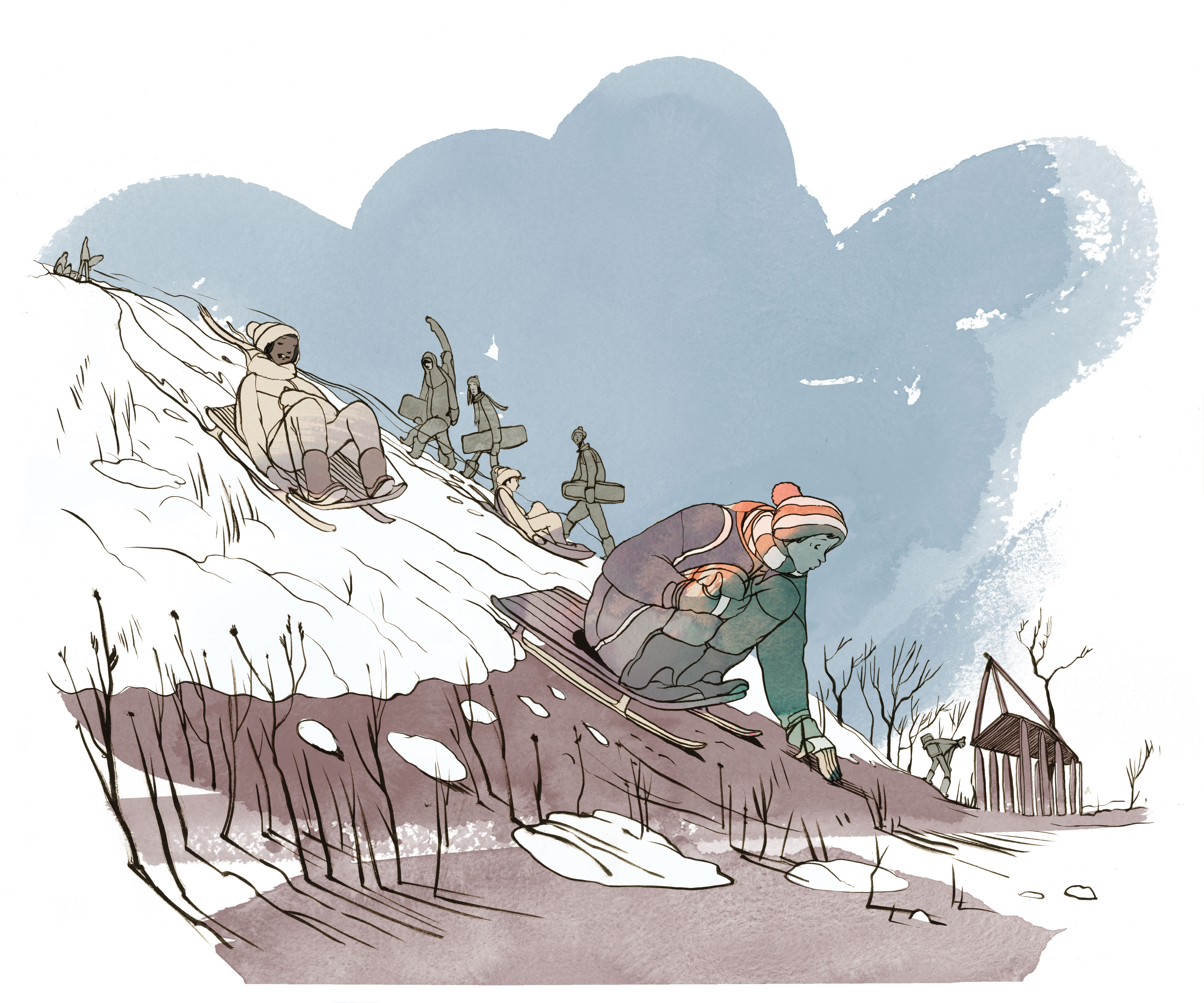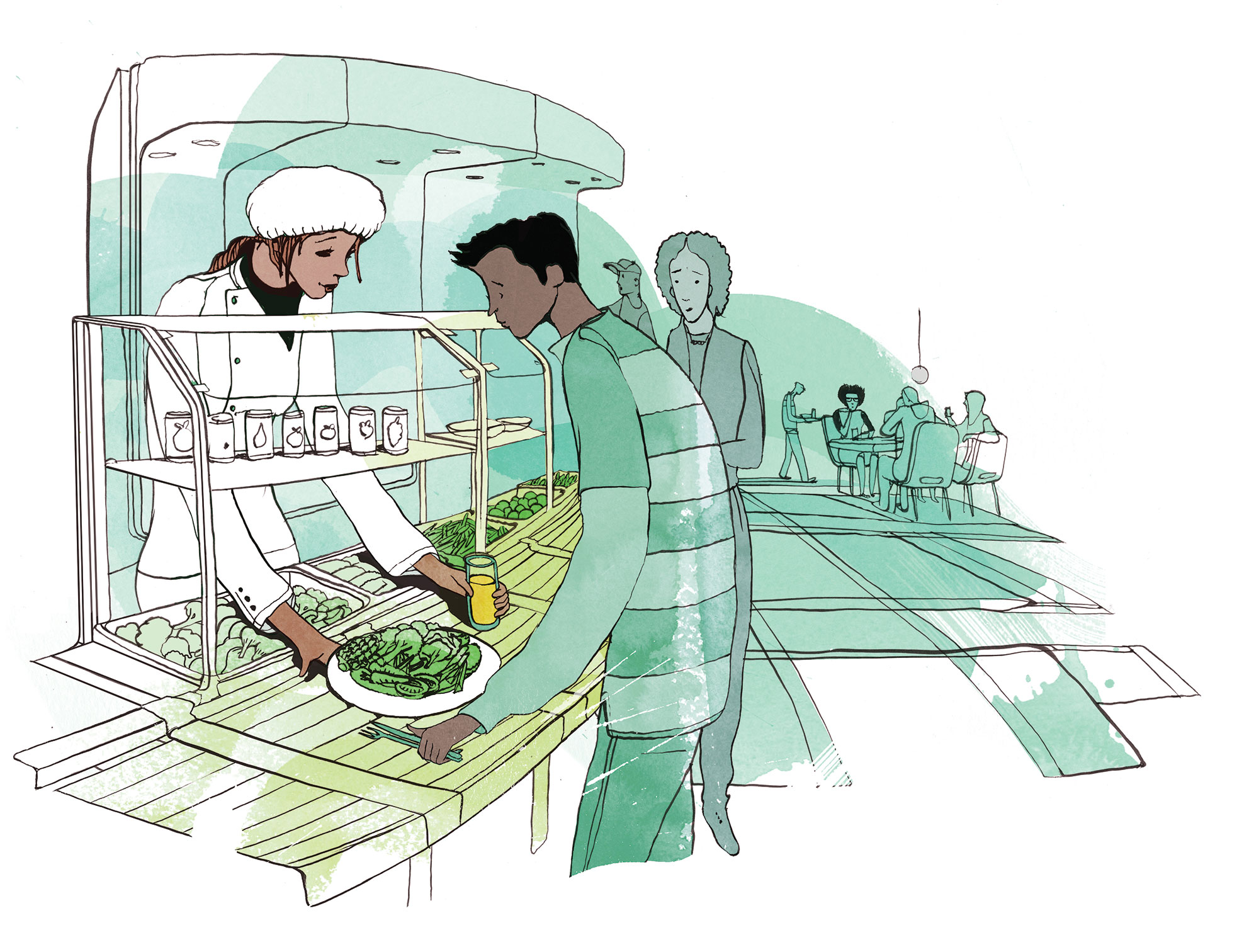
Climate Change Comes to Campus
Heat’s impact on health
The consolation for students of the 2050s is that all residence halls are likely to have air conditioning by then — and they’ll have to, for several health reasons.
“Those move-in weeks can be hot,” says Barb Frazee, executive director of University Residences. “But because we’re building two new halls and are hoping to build two more in the next 15 years, the halls that don’t have AC will become obsolete.”
Frazee says students with certain medical conditions can request a residence hall with air conditioning, and, so far, Purdue has been able to accommodate them. But the number of students with specific health requirements may increase by the middle of this century.
According to the IN CCIA report Hoosiers’ Health in a Changing Climate, rising temperatures increase production of ground-level ozone, an irritant linked to increases in cardiovascular and respiratory illnesses such as asthma, emphysema and chronic obstructive pulmonary disease.
The warmer temperatures that make moving day unbearable will cause a seasonal shift, too. Spring will arrive earlier and fall will last longer. The growing season will increase by 33 days in central Indiana. That’s more time for crops to grow, but also for allergens like ragweed to spread their misery to seasonal allergy sufferers.
Waiting on winter
Cool temperatures used to arrive by the end of the fall semester. Students of the 2000s blew off a little steam by “borrowing” trays from the nearest dining hall and taking them for a ride down Slayter Hill’s snowy slope.
Students of the 2050s will struggle to recreate this scene. First, the dining halls have gone tray-free. But this may not matter, since it’s unlikely that much snow will fall on Slayter in December. The chances will actually be low all winter.
In six of the 11 years from 2000 to 2010, at least 2 inches of snow fell on a day in the first half of December. But that’s less likely in the 2050s. Even with more precipitation falling in winter, low temperatures have been rising by 0.6 degrees per decade since 1950. In 2015, the average low temperature was 34.1 degrees — the first time the average was above the freezing point since recordkeeping began in 1895.

“Historically, in the colder months, about a quarter of our precipitation has fallen as snow. But in the future, that will decrease by half,” Dukes says. “There will still be the occasional snowy day, but the chances that a student will be able to go sledding on Slayter Hill will be about half of what they were in the past.”
Even on days when snow accumulates, it’s unlikely to last long. Snowfalls have historically layered on top of each other for much of the season, but warmer winters mean those accumulations are more likely to melt before another storm rolls in. “We’re going to lose something like three weeks’ worth of days with snow on the ground,” Dukes says.
Wetter and wilder springs
While winter will take its time arriving in West Lafayette, spring will be all too eager to make an appearance in the middle of the 21st century. With it will come warmer temperatures, more rain and changes to one of Purdue’s iconic spring events: Grand Prix.
The go-kart race held since the 1950s and billed as “the greatest spectacle in college racing” is a major draw for students and alumni in late April, but weather can make or break the event. And the springs of the 2050s will have more rain than those at the beginning of the century. Since 1960, Indiana has received an average of 1.33 inches more rain each decade, with nearly 30 percent of this increase occurring in the spring. Projections suggest that trend will continue.
“There are going to be some really big downpours,” Dukes says. “Whereas in the past you might have had a little rain and calling off Grand Prix would be questionable, you’re more likely to have a major downpour and have to cancel.”
If the race proceeds in inclement weather, rain can make watching it miserable for fans, and a wet track can be unsafe for drivers racing at high speeds and making quick turns.
“It’s tougher to run in the rain for go-karts than probably anything else,” says Danny White, director of Purdue Motorsports. “They just slip and slide all over.”
Heat can also create difficult conditions on an asphalt track that easily tops 100 degrees, even when the air temperature is much lower. White says the rubber compounds used in kart tires will have to change to become more heat-resistant. Otherwise, the tires are likely to blister easily.
At least one change at Grand Prix will be positive: The sounds and smells of the race will be different in the 2050s, as the roar of engines and exhaust fumes will soon be things of the past. The world’s largest regulating body for the sport, the Commission Internationale de Karting, announced a ban on gas engines by 2023.
“If you look at the carbon footprint generated by one kart in the Purdue Grand Prix, and how far you could drive in an automobile, you'd be shocked,” White says. A single go-kart engine running for one continuous hour, he explains, produces the same amount of air pollution as eight new cars running at 55 mph for an hour.
Modified meal plans
Another way the campus has changed in the last 20 years? The variety of food choices and places that students can eat or purchase food to go have increased dramatically. But climate change could undo that diversity and the affordability of what’s on the menu.
Changes in temperature and precipitation patterns are expected to decrease yields of corn and soybeans. While it’s possible that new varieties of these crop plants could improve heat and drought tolerance or increase yield, fluctuations in grain supply are expected to be the norm.
Rising temperatures will increase costs for animal operators, who will need to pay more to cool buildings or build shade structures to keep animals safe. The heat may also reduce milk production as much as 12 percent by the 2050s.
“Purdue freshmen in 2050 will start to see the crunch,” says Otto Doering, professor of agricultural economics and an author of the IN CCIA report Indiana’s Agriculture in a Changing Climate. “And it won’t be just climate change. It will be climate change in conjunction with other resource constraints.”

Animal-based protein, Doering says, is likely to become more expensive. Prices for animal feed will fluctuate based on yields affected by climate, and demand for meat will increase steadily as the planet nears more than 9 billion people by 2050. In the U.S., pastureland is being converted for row crops, limiting the space available to raise animals.
“Consumers want more grass-fed beef. They want more happy cows on pasture. And we’re getting to the point where the pasture isn’t going to be there to the extent that it was in the past,” Doering says. “Climate, in essence, puts some limitations on the pasture itself, but also physiological limits on the livestock as well.”
The change won’t happen overnight. Doering predicts that the prices of animal-based proteins will slowly rise faster than alternatives, making them more expensive treats rather than everyday options.
“If the livestock and dairy proteins are more scarce and expensive because of climate change and other resource availability, you change to vegetable proteins and other forms of protein for your diet,” Doering says. “I don’t think students of the 2050s walk in to the same options as students have now. I think some of these options just get priced out of the market.”
Students can lead the way
The effects of climate change are already apparent, based on the IN CCIA reports.
Mosquitoes and ticks, which carry diseases like West Nile virus and Lyme disease, are expanding their ranges. Heat and air pollution are increasing the occurrences of cardiovascular and respiratory illnesses. Native coldwater fish are vanishing as water temperatures rise and the fish find lower, cooler waters have inadequate oxygen levels based on increased farm field runoff. Forest makeup is shifting as the climate changes the types of trees and animals suited for Indiana.
Dukes says the situation becomes increasingly ominous the longer we go without making significant efforts to slow or stop the emission of greenhouse gases. But he sees hope in the students on campuses like Purdue. As the consequences of climate change become more apparent and green technologies become more cost-effective, students are learning what needs to be done.
“Awareness is increasing, especially among young people,” Dukes says. “Lots of people and companies around the country are already working to address climate change, and lots of our students are eager to join them. They can’t wait to help turn this around.”
